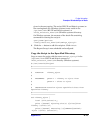
Further Information
Performance Considerations
Appendix AA-8
Performance Considerations
This section gives an overview of the most common backup performance
factors. It is not meant to discuss performance. Due to the high number
of variables and permutations, it is not possible to give distinct
recommendations that fit all user requirements and affordable
investment levels. Further discussions can be found in the HP OpenView
Storage Data Protector Concepts Guide.
The Infrastructure
The infrastructure has a high impact on backup and restore
performance. The most important factors are the parallelism of data
paths and the use of high speed equipment.
Network Versus Local Backups and Restores
Sending data over the network introduces additional overhead, as the
network becomes a component to performance consideration. Data
Protector handles the datastream differently for the following cases:
Network
Datastream
Disk to Memory to Network to Memory to Device
Local Datastream Disk to Memory to Device
In order to maximize the performance, it is recommended to use local
backup configurations for high volume datastreams.
Devices
The device type and model impacts the performance because of the
sustained speed at which a device can write data to a tape (or read data
from it). For example:
• DDS/DAT devices typically have a sustained speed of 510 KB/s to
3 MB/s, without compression, depending on the model.
• DLT devices typically have a sustained speed of 1.5 MB/s to 6 MB/s,
without compression, depending on the model.
• LTO devices typically have a sustained speed of 10 MB/s to 20MB/s,
without compression, depending on the model.


















